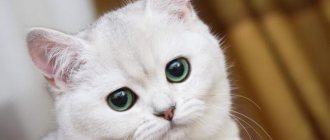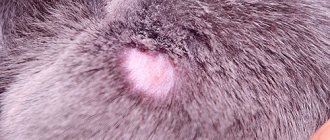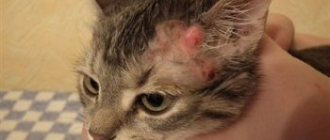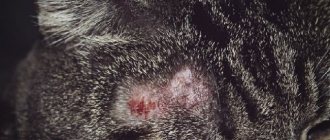Unfortunately, not one cat is immune from the appearance of lichen. The cause of the disease may be pathogenic microorganisms or allergic reactions. In the first case, long-term treatment will be required under the supervision of a veterinarian; in the second, diet correction and elimination of the allergen help.
Any cat can become infected with lichen, but most often young, old or weakened animals are affected. Strong immunity helps the body fight all kinds of diseases, including lichen, but does not protect pets 100%. Even cats that have never left the apartment can get sick, because the infection can be brought from the street on shoes. For the same reason, you should not allow contact with street animals and, upon returning home, wash your hands, clean your shoes and clothes.
Many lovers of four-legged animals simply do not know how to identify the disease and how to treat a cat if it has lichen. But it is important to remember that an accurate diagnosis and treatment can only be prescribed in a veterinary clinic.
Types of lichen in cats
True types of lichen in cats include the following diseases:
- Trichophytosis
- Microsporia
- Favus (Narsha)
Such types of cat lichen as: ringworm, pityriasis versicolor, pink and red lichen are not entirely scientific from a veterinary point of view, but are most understandable for animal owners.
Animal owners often classify lichen as a skin disease with a similar course, but caused by completely different factors and pathogens. For example, by weeping lichen, owners most often mean eczema - a completely different skin disease. In some cases, these are bacterial dermatitis.
What does ringworm look like in cats?
Ringworm in cats appears as multiple, limited areas of hairless, flaky skin. Around the source of the disease, the hair is usually brittle, it is shorter than the hair on unaffected areas, and looks as if it has been sloppily cut.
Ringworm in cats photo
Cats affected by fungal dermatitis have profuse dandruff. Sometimes the skin affected by the fungus becomes inflamed and begins to become wet (serous-purulent exudate is released).
Inflammation of ringworm in a cat
Under a Wood's lamp, ringworm in cats fluoresces with a greenish glow.
Ringworm in a cat under a Wood's lamp (Photo)
The causes of the disease are deprived
The cause of lichen is fungi. For example, fungi of the genus Trichophyton cause trichophytosis, Microsporam – microsporia, most often diagnosed in cats. Achoreon, which causes Favus (narsha) in domestic cats, is not common. But if your cat hunts a lot, she can catch this disease from mice.
According to statistics, microsporia accounts for more than 90% of fungal skin diseases in cats.
Infection is facilitated by contact between healthy cats and sick cats. For this, it is not necessary that animals communicate with each other. The owner can transfer the fungus on his hands, clothes, personal care items, especially combs. A pet can become infected with lichen even when hunting rodents. Provoking factors are crowded conditions, dirt, and high humidity in the room.
Kittens and cats under the age of 1 year are especially susceptible to infection. Animals with weakened immune systems, pregnant and elderly mustachioed pets. Ringworm in kittens is more severe and affects a larger area of the body.
Prevention for cats and people
Prevention measures for cats:
- the cat is fully fed;
- they are not allowed to go for walks on their own;
- treated against external and internal parasites;
- take care of the coat: regularly inspect, wash, comb out;
- do not ignore vaccination;
- keep the animal's area clean.
Prevention measures for humans:
- wash your hands after contact with stray animals;
- observe the rules of personal hygiene;
- in case of contact with a sick cat, use rubber medical gloves;
- If you don’t have gloves, wash your hands thoroughly and treat them with a 70% alcohol solution.
A variety of pharmaceutical drugs can help successfully treat your pet from shingles. The main thing is to be patient and meticulously follow the veterinarian’s recommendations.
Ringworm in cats
Ringworm is the most common type of ringworm in cats. When talking about this disease, they mean microsporia and trichophytosis. These fungi spread very easily among animals. Ringworm also poses a danger to children and people with weakened immune systems.
Ringworm in cats (Photo)
The incubation period for ringworm in cats is short. 2-4 days from the moment of infection to the first symptoms
.
It is important for the owner to know what ringworm looks like in cats. Keep in mind that kittens are most susceptible to this disease.
Symptoms of ringworm
The picture of the course of ringworm is classic. Along the body, most of the back of the head, neck, sides and shoulders, there are small bald patches, around which the hair is very brittle. The causative agent of ringworm in cats does not cause symptoms of itching; pets rarely scratch the affected areas.
Ringworm in a cat (Photo)
Diagnostics
Symptoms of ringworm are characteristic of many dermatitis. Therefore, laboratory diagnostics come to the rescue. The most accurate method is to examine cat hair for the presence of ringworm pathogen under a microscope. The doctor takes the hair and examines it microscopically; fungus is usually visible in the keratin part of the hair.
Wood's lamp also helps diagnose dermatomycosis, but is not the most reliable method. It produces fluorescence only on some pathogens; more than half of the common fungi do not glow with a characteristic greenish glow.
Treatment of ringworm in cats
Treatment for ringworm is not always difficult. In most cases, the disease goes away on its own within 2 weeks, even without treatment. The owner’s task is to provide the pet with adequate nutrition, ensure that the disease is not complicated by a bacterial infection, and prevent infection of other animals.
In case of severe damage, special antifungal drugs are used. They are used in the form of ointments, and in severe cases, by injection or in tablets. These drugs require precise dosing, so they must be prescribed by a veterinarian during a clinic appointment.
The use of sulfur and iodine preparations is quite controversial. Iodine has almost no fungicidal effect and can cause allergies. At the concentration in which sulfur is contained in the ointment, it has no effect on many fungi, and higher concentrations of sulfur cause skin irritation. It is worth considering that many sulfur ointments contain tar and turpentine, which are toxic to cats.
There is a vaccine against ringworm. Despite its widespread use, there are no reliable studies proving its effectiveness for the prevention of lichen, yet it is safe and slightly accelerates recovery in therapeutic doses, using complex therapy.
Possible complications
If left untreated, lichen takes on a chronic form, from which the cat will suffer for the rest of its life. The affected areas fester, become inflamed, and subsequently the skin and lymphatic tissues suffer.
In other cases, microsporia is not dangerous. It does not affect internal organs, does not have a negative effect on reproductive function and does not limit the furry’s mobility after recovery.
After treatment for lichen, the cat is left with unaesthetic scars, pigmentation and bald patches on the affected areas of the dermis. However, these are just cosmetic flaws that do not cause concern to the four-legged pet.
Pityriasis versicolor in cats (variegated)
By pityriasis versicolor, doctors mean malasseziasis of the skin, a disease that has a similar clinical picture. The causative agents of the disease are fungi of several species: Malassezia pachydermatis, Malassezia nana, Malassezia slooffiae. A key role in the development of pityriasis versicolor in cats is decreased immunity.
Pityriasis versicolor (variegated) in a cat (Photo)
Symptoms of pityriasis versicolor
Tinea versicolor in cats prefers to develop in warm and moist areas of the body. Most often, Malassezia affects the auricle, nose, perineum, abdomen and armpits, between the fingers.
Treatment of pityriasis versicolor
Treatment of pityriasis versicolor is carried out comprehensively. Antifungal drugs and drugs that stimulate the immune system must be prescribed. The cat's place of residence is treated with disinfectant solutions and quartzing is carried out in the room where the pet lives.
Pityriasis rosea (shingles)
Tinea rosacea (shingles) in cats (Photo)
A non-contagious disease, presumably of an allergic nature. The causative agent is not exactly known. Sometimes pityriasis rosea in cats occurs after a herpesvirus infection (FHV-1).
Is pityriasis rosea contagious for cats?
Pityriasis rosea is a non-infectious disease. It does not pose a danger to other pets.
Is pityriasis rosea transmitted from cats to humans?
No, it does not pose a danger to humans, unlike ringworm and pityriasis versicolor.
Symptoms of pityriasis rosea
Pityriasis rosea appears in cats on the face, near the eyes and nose, limbs, and less often on the stomach; erosions and round ulcers form. After a few days it becomes covered with a crust, which gradually falls off. Unlike ringworm, pityriasis versicolor is accompanied by moderate to severe itching. In kittens, pityriasis rosea is less common than in adults.
Treatment of pityriasis rosea
Unfortunately, no medicine can eliminate the virus. Treatment of pityriasis rosea in cats and kittens is symptomatic. Antiseptic drugs are used locally. Sometimes immunostimulating drugs are prescribed. The pet's diet is enriched with vitamins and essential amino acids.
If a person is infected with shingles
A person who keeps furry pets in the house must be prepared for the fact that some diseases can spread from a sick cat to all family members.
Treatment of a person infected with lichen from a cat is carried out in parallel with the treatment of a pet. Complex therapy is used:
- all sore spots are treated with antifungal ointments, iodine, fucarcin;
- during treatment, do not take a bath or rub the skin with a washcloth;
- take antifungal and antihistamines orally;
- The diet includes a complex of vitamins.
Ringworm in cats (eczema)
Eczema, popularly called pityriasis versicolor, can occur in several cases. Pathogenic bacteria can enter skin damaged by the fungus, which will lead to a complicated course of the disease. In other cases, the cause of weeping eczema may be hormonal imbalances, stress, flea dermatitis, or allergies.
Ringworm in a cat (eczema, photo)
Symptoms of weeping lichen
Bald, weeping spots with blisters form on the skin. The fur around is not brittle. Dandruff is rare. The skin in these places is red, hot to the touch, and painful.
Treatment of weeping lichen
Treatment depends on the cause of the disease, therefore, at home, without diagnostics in the clinic, it is impossible to select an effective treatment regimen for lichen.
Ringworm
Lichen planus in cats is a concept transferred to veterinary medicine from human medicine. This disease is not considered in cats. As a rule, this refers to non-infectious, chronic dermatitis caused by allergies or a malfunction of the immune system. May occur after infectious diseases.
Symptoms of red lichen
The symptoms of ringworm in cats resemble eczema, with the only difference being that the surface of the skin is dry. Reddish plaques form on the skin. At first these are small spots, which as the disease progresses form a large spot. Plaques are located in the groin, joints and abdomen.
Treatment of red lichen
There is no effective treatment for ringworm in cats, either at home or in the clinic. Medications are used to relieve symptoms and itching.
What to do at the first sign of lichen in a cat
What to do if the first signs of lichen are detected in a cat?
- Do not panic, do not self-medicate, and do not resort to dubious methods of traditional treatment. Particular attention should be paid if signs of lichen are found in a kitten.
- Contact a veterinary clinic. Be prepared to tell your doctor about your pet's diet and lifestyle. Remember the date of your last vaccination and deworming.
- At the appointment, the doctor must carefully examine the pet, take scrapings from the skin and hair for examination under a microscope. As an additional study, you can illuminate the cat with a Wood's lamp. The doctor must also exclude differential diagnoses. For example, with a spot resembling lichen on the ear, it is necessary to exclude otodectosis and demodicosis.
- If ringworm or multicolored lichen is confirmed, the doctor will prescribe antifungal medications and give advice on nutrition and strengthening the cat’s immunity.
Diagnostics
At the first visit, the veterinarian finds out from the owner what is bothering the animal and examines it using a Wood lamp, in the fluorescent rays of which the infected areas glow green.
During microbiological analysis, the causative agent of the infection is determined. For this purpose, the affected area is scraped and placed in a nutrient medium, after which the grown microflora is examined under a microscope. The method is considered the most reliable, but takes time (up to 3 weeks).
Prevention of lichen
Healthy adult animals almost never get fungal skin diseases. And for the most vulnerable groups of cats, prevention of lichen consists of maintaining sanitary conditions and preventing contact of animals suspected of being infected with dermatomycosis with healthy pets, balanced feeding and prevention of viral and bacterial diseases.
Vaccination of cats against shingles is a controversial topic. Its effectiveness as a prophylactic agent has not been proven. Independent studies conducted in Europe and the USA have failed to prove the benefits of these drugs. Abroad they do not vaccinate against lichen. Proof of this is that it is impossible to find a single imported vaccine against dermatomycosis on sale. There are no studies proving the harm of such drugs.
Treatment of lichen at home
To cure your pet you will need to follow a number of rules:
- The room where the cat is kept must be regularly cleaned and disinfected. Sterility is the enemy of fungi;
- ointments and sprays are used to treat foci of the pet’s disease 2-3 times a day for 2 weeks;
- wash the cat with antifungal shampoos twice a week for 6 weeks;
- Injections against feline lichen . There are contraindications for pregnant women, nursing kittens and kittens under 2 months. The prices for lichen vaccines for cats are low, but the effect is excellent;
- the use of griseofulvin, itraconazole, and ketonazole tablets. The drugs are given every 12 hours at a dose of 5-10 mg per 1 kg of body weight;
- stains can be treated with iodine, which will promote their speedy healing.










